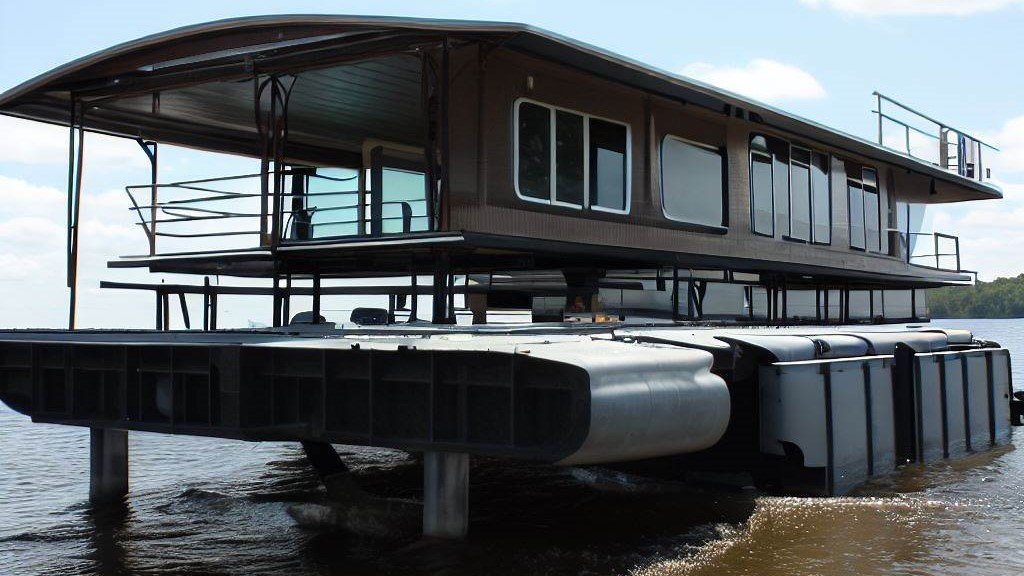Underpinning is the process of adding a protective layer of sheet metal on the underside of a pontoon boat. It covers the gaps and protrusions between the pontoons and creates a smooth surface for water flow.
Underpinning can enhance the performance, durability, and fuel efficiency of your pontoon boat, as well as make the ride more comfortable and enjoyable.
If you are a pontoon boat owner or enthusiast, you might have heard about underpinning as a way to upgrade your vessel. But what exactly is underpinning and how does it work?
In this article, we will explain everything you need to know about underpinning, including its benefits, costs, and installation process. We will also answer some frequently asked questions about underpinning and provide some tips on how to maintain it.
What is a Pontoon Boat?
Before we dive into underpinning, let’s review what a pontoon boat is and how it differs from other types of boats. A pontoon boat is a flat-decked boat that floats on two or three cylindrical tubes called pontoons. These pontoons are made of aluminum and filled with air or foam to provide buoyancy. The deck can be customized with various features and accessories, such as seats, tables, railings, canopies, ladders, speakers, etc.
Pontoon boats are popular for recreational activities, such as cruising, fishing, swimming, tubing, and sunbathing. They are ideal for lakes, rivers, and calm waters, but not for rough seas or high speeds. Compared to other boats with V-shaped hulls, pontoon boats are more stable, spacious, and versatile, but less maneuverable, agile, and fast.
What is Underpinning?
Underpinning is a common modification that many pontoon boat owners choose to do to improve their boats. It involves attaching a thin sheet of aluminum or other metal to the bottom side of the deck, covering the area between the pontoons. This creates a smooth and continuous surface that reduces water resistance and drag.
Underpinning has several advantages, such as:
- Improving performance: Underpinning can increase the speed and acceleration of your pontoon boat by reducing drag and allowing it to glide more easily through the water. It can also improve the handling and steering of your boat by reducing the effects of crosswinds and waves.
- Saving fuel: Underpinning can lower the fuel consumption of your pontoon boat by making it more efficient and requiring less engine power to move. This can save you money and reduce your environmental impact.
- Protecting the deck: Underpinning can shield the underside of your deck from water damage, corrosion, and debris. It can also prevent water from splashing up and soaking your feet or belongings on the deck.
- Enhancing comfort: Underpinning can make your ride smoother and quieter by reducing the noise and vibration caused by water hitting the bottom of your boat. It can also prevent water from spraying up and hitting your passengers or equipment.
How Much Does Underpinning Cost?
The cost of underpinning depends on several factors, such as the size and shape of your pontoon boat, the type and quality of the metal sheet, and the labor and installation fees. Generally, you can expect to pay anywhere from $300 to $1000 for underpinning, depending on these variables.
Some pontoon boat manufacturers offer underpinning as an optional feature that you can add to your boat when you buy it. This might be more convenient and cheaper than doing it yourself or hiring a professional later. However, you can also find underpinning kits online or in stores that provide you with the materials and tools you need to do it yourself. Alternatively, you can hire a marine dealer or mechanic to do it for you, but this might be more expensive and time-consuming.
How to Install Underpinning?
The installation process of underpinning varies depending on the type of kit or service you choose. However, the basic steps are as follows:
- Step 1: Prepare your boat. Make sure your boat is clean, dry, and free of any dirt or debris. You might need to remove some parts or accessories from your deck, such as seats, rails, or lights, to access the underside. You might also need to lift your boat off the ground or water using a trailer or a lift.
- Step 2: Measure and cut the metal sheet. Measure the length and width of the area between your pontoons and cut the metal sheet accordingly. You might need to use a saw, a drill, or a metal cutter to do this. Make sure the sheet fits snugly and covers the entire area without any gaps or overlaps.
- Step 3: Attach the metal sheet. Use screws, bolts, rivets, or adhesive to secure the metal sheet to the underside of your deck. Make sure the sheet is aligned and flush with the edges of your deck and pontoons. You might need to use a hammer, a wrench, or a screwdriver to do this. Make sure the sheet is firmly attached and does not move or rattle.
- Step 4: Finish and test. Replace any parts or accessories you removed from your deck and lower your boat back to the ground or water. Check for any leaks, cracks, or loose parts and fix them if necessary. Test your boat on the water and enjoy the improved performance and comfort.

How to Maintain Underpinning?
Underpinning does not require much maintenance, but you should still check it regularly for any signs of damage or wear and tear. You should also clean it occasionally with mild soap and water to remove any dirt or stains. If you notice any rust, corrosion, or holes in your metal sheet, you should replace it as soon as possible to prevent further damage.
FAQ
Here are some frequently asked questions about underpinning:
- Is underpinning worth it? Underpinning can be worth it if you want to improve the performance, durability, and comfort of your pontoon boat. However, it might not be necessary if you are satisfied with your boat’s current condition or if you only use it occasionally or at low speeds.
- Does underpinning affect the weight capacity of a pontoon boat? Underpinning does not affect the weight capacity of a pontoon boat significantly, as the metal sheet is usually very thin and light. However, you should still follow the manufacturer’s recommendations on how much weight your boat can safely carry and distribute it evenly on the deck.
- Can I remove the underpinning from my pontoon boat? You can remove the underpinning from your pontoon boat if you want to, but you might need to use some tools and force to do so. You might also damage the underside of your deck or leave some holes or marks on it. You should also consider the benefits of underpinning before deciding to remove it.
Conclusion
Underpinning is a simple but effective way to upgrade your pontoon boat and make it more enjoyable to use. It can improve the performance, durability, and comfort of your boat by creating a smooth surface for water flow and reducing drag. It can also save you fuel and protect your deck from water damage and corrosion.
If you are interested in underpinning your pontoon boat, you can either buy a kit and do it yourself, or hire a professional to do it for you. Either way, you should make sure you have the right materials, tools, and skills to do the job properly and safely. You should also check and clean your underpinning regularly to keep it in good condition.
We hope this article has answered your questions about underpinning and helped you decide whether it is something you want to do for your pontoon boat. If you have any comments or suggestions, please feel free to share them with us. Happy sailing!

